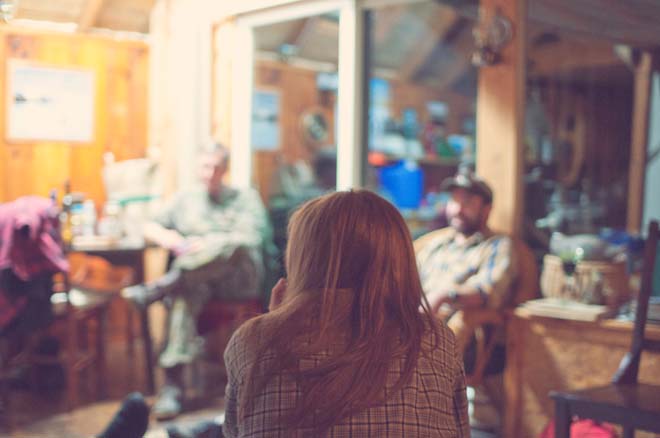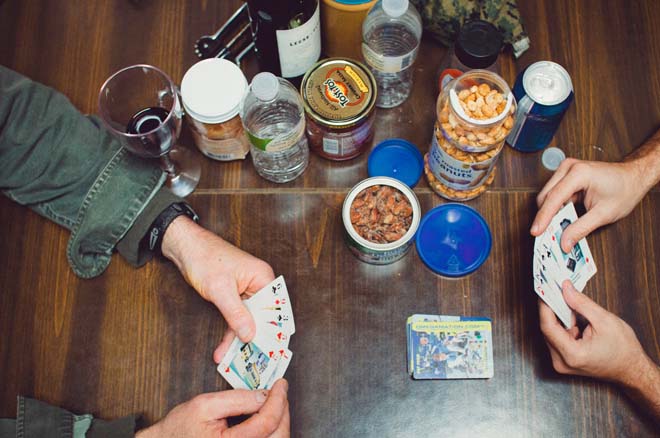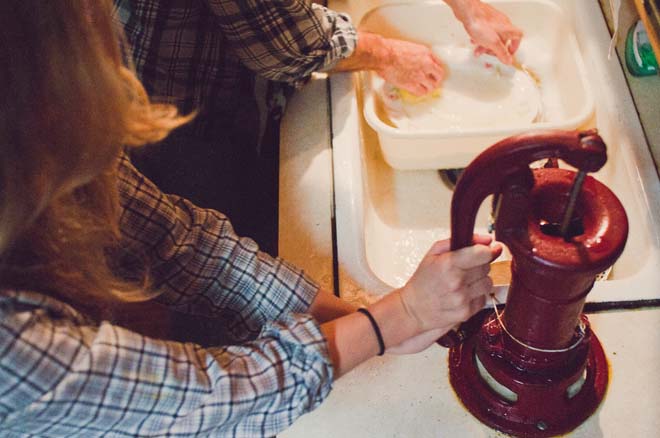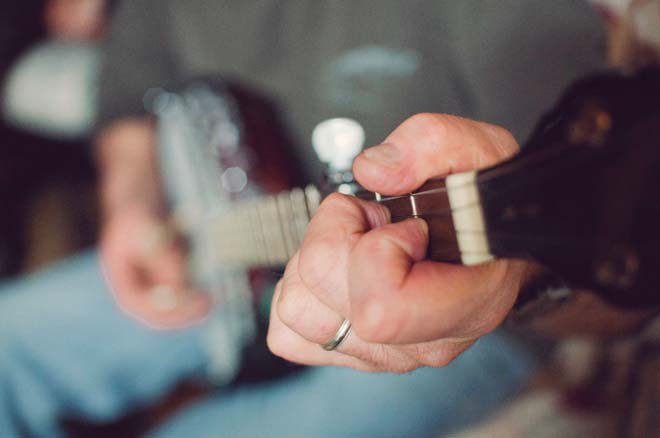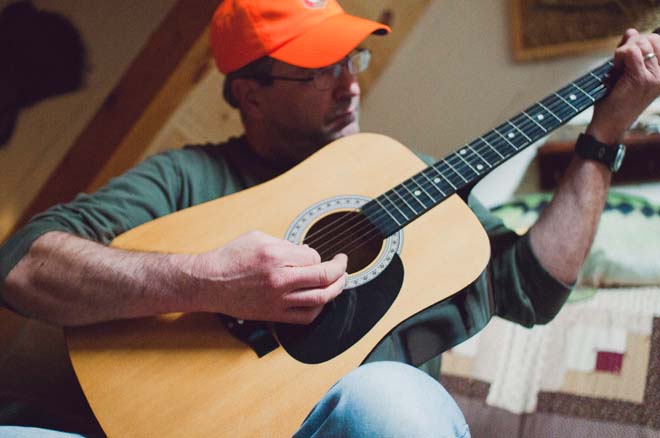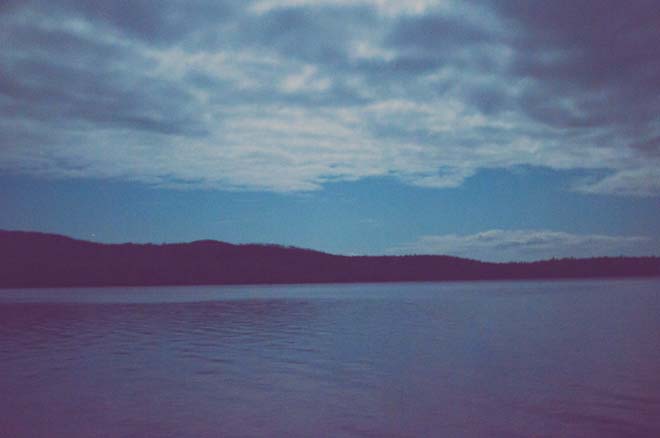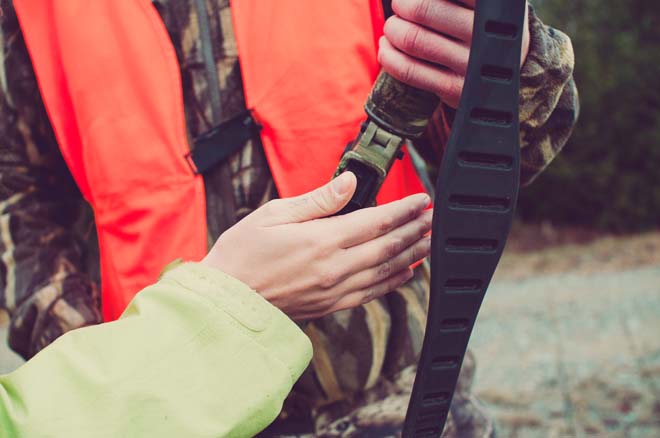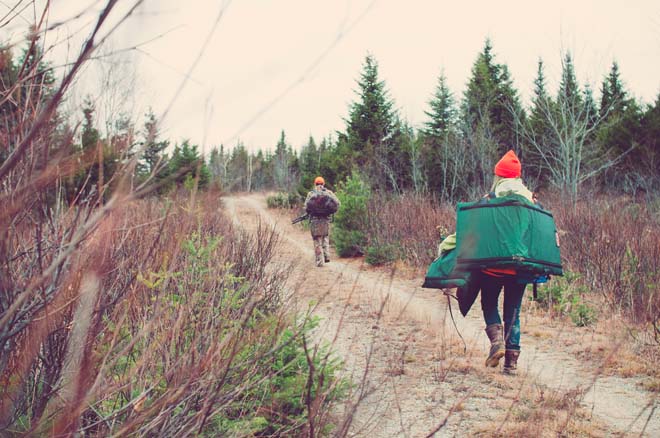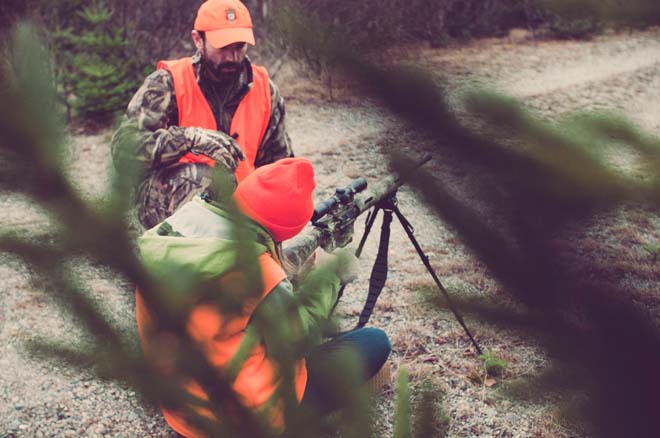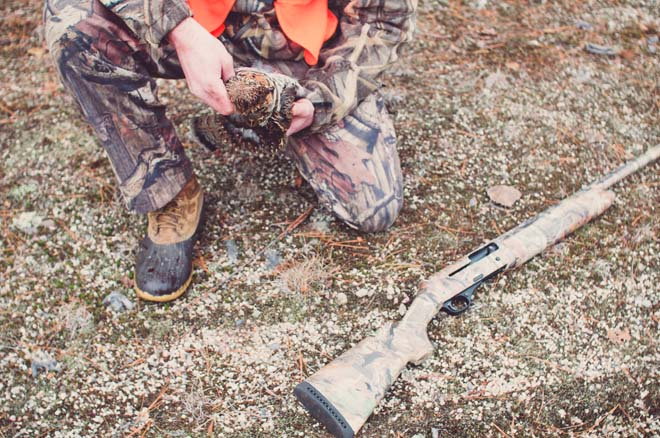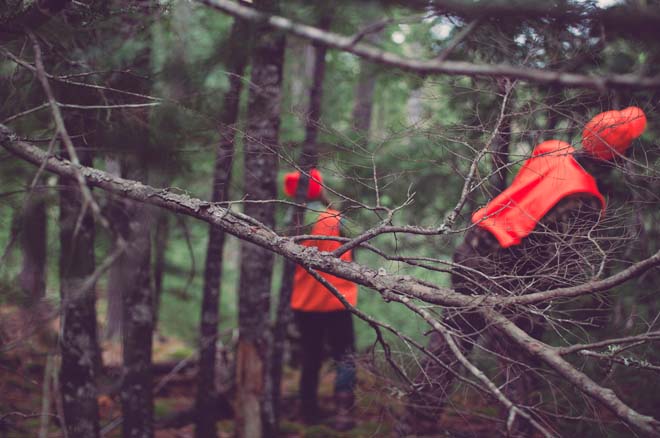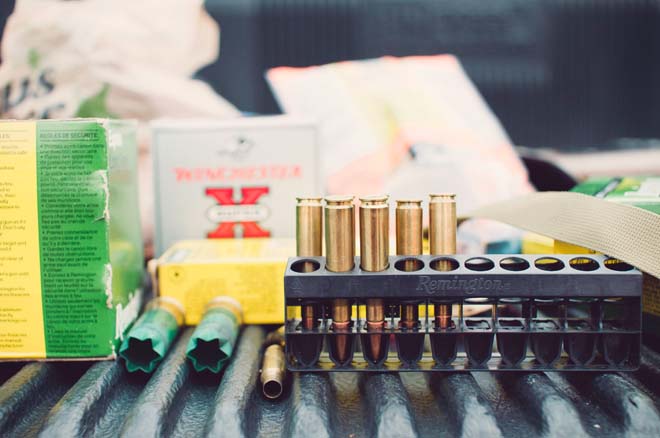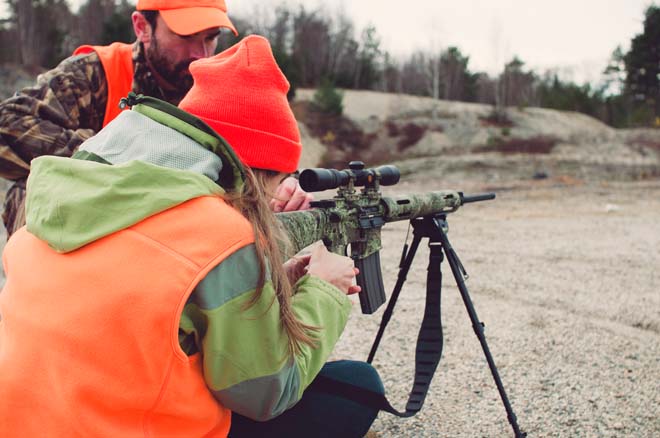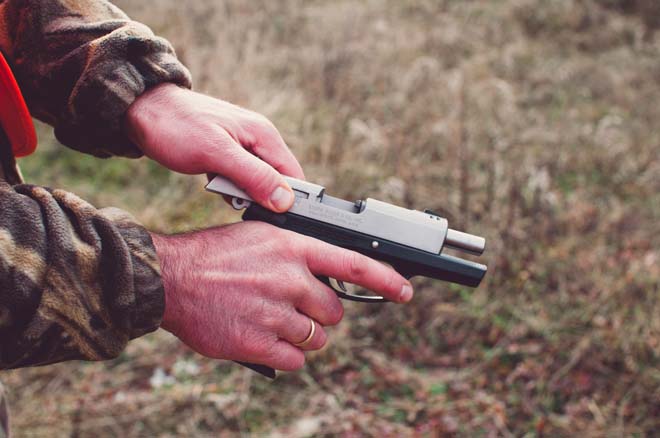Alive and Well in Lonely Country
FEATURE-November 2012
By Sophie Nelson
Photographs by Erin Wallace
A novice hunter takes a trip up to camp.
The leaves have fallen and turned to rot, and the sky can only manage varying shades of gray. Photographer Erin Wallace meets me in Augusta and together we continue north into the fast-falling night. Beyond Brewer, we follow a scar of highway through endless forest, navigate gnarly back roads, and eventually find it: a camp with a set of caribou antlers over the doorway, the place my friend Steve Vose escapes to every autumn. In the warm interior, I encounter a blur of camouflaged limbs and Bean boots, rag rugs, and a wood stove. I take a seat and drink when they’re offered to me. Faces come into focus. I smile and receive several smiles in return.
Steve’s father is also named Steve. He wears a soft, green corduroy shirt, worn jeans, and a neon-orange hat, and welcomes me with a warm handshake. Steve senior is joined by his friend John, and when I inquire about how they know each other, John kindly offers the backstory. John is originally from Caribou and met Steve in the 262 Engineer Battalion in Calais/Brewer. Steve, John, and their other military buddies gather at Deer Camp as often as they can, but this year just the two of them could make it.
“I want to tell you about a year when shooting a deer really mattered.” Steve senior says, confirming my suspicion that Deer Camp often has little to do with deer. He throws a glance toward John, who shifts his position and drops his gaze to hear Steve senior trace the story already etched in his memory. “Deer Camp 2005. It was the military group so we met in Calais. We were bummed because two were going to be deployed to Afghanistan. I had promised I would take John’s boys ice fishing while he was gone. After breakfast, we went out for a hunt and John shot a buck. It was the first deer we ever shot at Deer Camp, and it boosted moral so much we went to Walmart and bought one of those talking heads. It became the mascot. We didn’t meet again for another two years because of the war.” It’s Veteran’s Day, and I think about the way Portland’s Congress Street looked in the morning, filled with proud men in crisp suits and little boys and girls waving miniature flags with a fervor that didn’t quite fit the gray day.
As with any tradition, a healthy degree of nostalgia comes into play at Deer Camp. It’s clear that Steve and his brother Matt know the 2005 story well. I imagine that similar stories filled their home when they were kids, and that those stories, like this one, made them wonder—however subconsciously—what about Deer Camp wasn’t being communicated, or couldn’t be. “How old do you have to be to come to Deer Camp?” I ask, and Steve senior answers without hesitation: “Old enough to drink.”
The camp we’re in is Matt’s. Unlike the neighboring camp, a sizable house topped with a satellite dish, Matt’s is fairly small and rustic. Steve senior recently renovated his own camp, which is about an hour and a half from the one we’re in, and the men tell me that modernizing old camps, or building them from the ground up with all the amenities, is a growing trend. I’m glad they met me here, in a camp with neither running water nor cell-phone reception, but I also wonder about the less quaint aspects of Deer Camp that I may be missing out on. I am, after all, here with the sole intention of breaking the cardinal rule: “What happens at Deer Camp stays at Deer Camp.”
As a group, they are quiet at first. Steve is his usual jokester self, and I sense familial playfulness in Matt, but it takes a little while to emerge. John, in head-to-toe camouflage, seems to prefer listening to talking, and the same goes for Preston, Matt’s friend and a fellow engineer at the Bucksport Mill. They tell me that another one of their colleagues, a “city boy” from Waterville, will be joining us later. Preston pipes up when I ask the men about the first time they ate an animal they had killed. “It was a frog with a BB gun,” he says. “I shot it and my dad said, ‘You shot it, you eat it.’ So I cooked up some frog legs. They really taste like chicken.” Matt adds, “Partridge for me. It always tastes better when you killed it.”
After a dinner of meat and potatoes, I help Preston pump water for the dishes and Matt places a pot on the woodstove at his dad’s request—Steve senior wants to be sure Erin and I have the option of washing up with warm water before bed. We reconvene around the stove, and Steve senior brings out his banjo. Over the course of the evening, Steve and Matt never seem more like brothers than when they’re singing and tapping their muddy boots in unison. Their voices are good and strong and gruff around the edges. “You picked a fine time to leave me Lucille/With four hungry children and a crop in the field…,” they sing. I’m the only one familiar with Simon and Garfunkel’s “The Boxer,” and offer a sloppy solo, nodding my head in time with Steve senior’s, watching his mouth shape the words I almost know, watching a smile come over his face when I get a line just right. I’m unsure of myself, but he keeps pulling the song from me; he is the kind of teacher that tricks a kid out of thinking she has nothing left. When Steve senior and John leave—they’re heading to Calais to hunt that spot where John got a deer half a dozen years ago—I am sad to see them go. Chris from Waterville has brought his iPad, and we resort to his hip-hop playlist. Preston nods off on the couch with Mally, Matt’s affable yellow lab, asleep on his knee.
In the morning, I head to the dock with a steaming cup of coffee. The air tastes sweet it’s so clean, and I imagine the water does too but don’t dare disrupt it with a dip of my hand. In the spirit of trying new things, I eat corned-beef hash along with the eggs Steve scrambles, and don an orange vest and hat over my odd assemblage of winter gear. Hunting starts up with Steve’s truck. Erin, Steve, and I bump along back roads toward a location he has in mind, scanning the ditches for partridge collecting pebbles for their gullets. I try to concentrate but I’m preoccupied with the gun rattling between my thigh and the truck’s center console.
As the car slows to a stop on the side of an old logging road, I sense a shift in Steve; his mood takes on a new and appropriate depth. He moves soundlessly down the path, rolling his feet carefully over the stones so that they don’t crunch under his weight while pointing out moose prints, nibbled branches, and scat containing tufts of coyote fur. Steve sets up speakers that correspond with an electronic game caller so that, from within the blind, we need only push a button to fill the silence with the wails of a wounded hare. We are in for coyote, not deer. In a whisper, Steve tells me about overpopulation and the trouble coyotes have caused. He doesn’t eat coyote, but he does make pelts with their hides.
We wait. My fingers and toes prickle as they freeze. Steve tells me about the season he spent 200 hours in a deer stand. He saw some deer, but none that were shooting size. The rule is one deer per year, and Steve is after a deer that will meet or exceed the 10 pointer his Mom shot in 2008. He speaks bitterly about the hunters who “go out at night and kill 15, 16 a year.” As a boy, he used to wander around his family’s many acres in Calais without spotting a single deer, and he worries that his sons will never have the opportunity to hunt.
The wail of the electronic hare crescendos. After about an hour, we call it quits, pack up the blind, and begin talking at normal volumes—though after so much whispering it seems inconsiderate somehow. Steve tells me it’s time for target practice. I lean the butt of the .223 R15 rifle into my shoulder, center the log between the crosshairs, and pull the trigger. The sound and the kickback I expect, but the feel of the bullet ripping though the barrel of the gun is terrifying. We spend the morning shooting, driving down logging roads en route to somewheres that seems like nowheres, listening to country music and gnawing on home-smoked duck jerky, passing only hunters in trucks and men driving 18-wheelers. Maine is a vast and empty state, and that is precisely what Steve loves most about it. I understand the appeal on a theoretical level, but in actuality I find these woods coarse and lonely.
Late in the afternoon, cold to the bone and marveling at Steve’s dogged approach to the day, I somehow spot three partridge on the side of the road. I holler and point and, in the blink of an eye, Steve is out of the car poised to shoot. His excitement is palpable, rippling off of him and warping the air around us. At some point, we startle the partridge into flight and a vague shape—a brown smear on the gray sky—appears over the treetops. He shoots and the bird plummets. Soon afterward, he emerges from the woods carrying the floppy carcass by the feet. With his calloused and bloodied hands, Steve spreads open the bird’s intricate wings. Then, still intoxicated with adrenaline, he pulls the carcass apart to reveal the perfect pink breast that will be his dinner.
Later that afternoon, I see another partridge on the side of the road and it’s my turn to approach it with a gun in hand. I hold the heavy shotgun to my shoulder and Steve follows closely behind, whispering instructions in my ear. Raw excitement overcomes him again, and rather than focus on the task at hand, I wonder about the source of it. I wonder where to aim to kill the bird, and whether or not I am capable of pulling it apart in the event that I somehow manage to shoot it, and, in that case, if I have any business killing it in the first place. I shoot and miss. To my relief, the partridge disappears into a dense, moss-covered patch of forest. Steve checks for it. We wait for a while. It never reappears.
Toward the end of the day, as pinkish dusk settles over a swamp, Steve spots a flock of ducks at the mouth of a river. I can hear them but not see them, despite his best efforts to point them out. He tells me that he has the right shotgun, but the wrong bullets, and as if on cue, they ascend to form a flying V and come curling toward us, honking irreverently.
On the way back to camp, I think about the photos that hunters collect of themselves holding their kill by the antlers. Despite their unsteady smiles—or perhaps because of them—they don’t look happy, exactly. To me, hunting seems more about thrill than kill, about appreciating life in an acknowledgement of death and thereby living with a rare acuteness, even if only for the amount of time it takes a doe to flick her white tail. I think about Steve, who describes the habits of animals with the knowledge and tenderness of a parent prepping a babysitter. He wakes when they wake and sleeps when they sleep. He studies their miraculous anatomy and warps his mouth to mimic their sounds.
This part of Maine is not in fact empty.

